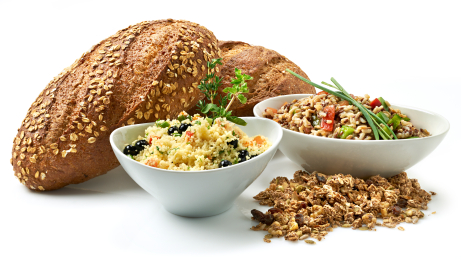
It’s a question many of us have and fail to fully consider—what exactly is the nutritional difference between white and wheat foods? The answer is not easy to find on your standard food labels, and the search for a true nutritional value takes some effort and understanding. Read on to find out how you and your family can get grain-savvy and make important decisions that can affect your health every day.
White
When picking up a loaf of white bread at the grocery store, you most likely see the word “enriched.” Although it sounds healthy, the enriched flour used to produce the loaf of bread in your hand was first stripped of important nutrients such as B vitamins and iron, and later “enriched” by adding a fraction of the original nutrients back in. It is shown that about 30 nutrients are removed during the milling process, and only a minimum quantity must be added back in by law. It’s not possible to add fibre back in, creating a major dietary gap in your daily nutrition. Although tastier and easier to digest, white bread has some definite drawbacks.
Wheat
We may have been trained that wheat is superior to white, but one vital word is the key to the best nutrition possible: whole. Wholemeal or whole wheat is exactly what it sounds like—made from the whole wheat berry. Standard wheat flour is actually just as refined as white flour. Whole wheat uses the entire grain kernel while milling, keeping important vitamins and nutrients readily available to benefit your body upon digestion. The fibre in whole wheat grain helps prevent constipation and keeps bowels regular. Folate, riboflavin, and Vitamins B1, B3 and B5 add an extra boost to your dietary needs. A 2003 study conducted by the University of Washington reported that switching from white to wholemeal bread can lower the risk of heart disease by 20%.
Why is it important?
Our bodies naturally break down carbohydrates into glucose, a simple sugar. This process directly affects our glycemic index (GI), which measures how fast glucose circulates through the body and provides fuel to cells. High GI foods can produce rapid blood sugar spikes and subsequent crashes, leaving you hungry shortly after eating. Foods with a low GI absorb into the body slowly, satisfying you longer after the meal. According to Harvard Medical School, whole wheat flour has a GI of 51 whereas white flour totals a GI of 71. This difference can affect blood sugar, making whole wheat grains the best choice for diabetics or those just looking to stay healthy.
Another Harvard study researched a total of 75,000 nurses and found that those who ate at least three servings a day of whole grains cut their heart attack risk by 35% and were also less likely to experience weight and bowel issues. On the other hand, those who ate more processed foods such as white bread and white rice were more than twice as likely to develop diabetes.
Making the change
Small substitutions in your diet are a great way to start a healthier pattern of eating grains. Check out the nutritional labels at the grocery store and search for wholemeal or whole wheat flour. Labels featuring 100% whole wheat are what you should be looking for, whereas a label of simply “whole wheat” could mean a mixture of whole wheat and white flour. When cooking at home, try substituting whole wheat flour for all-purpose flour, or mix them so that key nutrients are still available to you and your family.
Gluten free? No problem. Since avoiding wheat is a must, keep your eye out for gluten-free whole grain foods. Instead of wheat, whole grain options use other grains such as buckwheat, corn and quinoa. Whole grains provide many of the same nutrients as whole wheat, offering a healthy solution to those who don’t want to give up their carbs. Whole grain choices also contain less fat than whole wheat, adding another healthful aspect to your gluten-free diet. One of the most popular and least well known whole grain options is popcorn, which can provide a fun and healthy snack any time.
Regardless of your preference or health status, Reliv offers cutting-edge products to help fill in the nutritional gaps. FibRestore® offers a patented blend of soluble and insoluble fibre to support your digestive health. Reliv Now® with Lunarich® provides ideal gluten-free options for those looking for a balanced diet packed with vitamins, minerals and antioxidants. After all, man cannot live on bread alone.
Sources
http://www.livestrong.com/article/549358-what-is-the-difference-between-whole-grain-enriched-flour/
http://healthyeating.sfgate.com/healthy-wholewheat-flour-vs-white-3305.html
http://blogs.cbn.com/healthyliving/archive/2010/06/21/whole-wheat-vs.-white.aspx
http://www.vegetariantimes.com/article/white-bread-vs-wheat-bread/